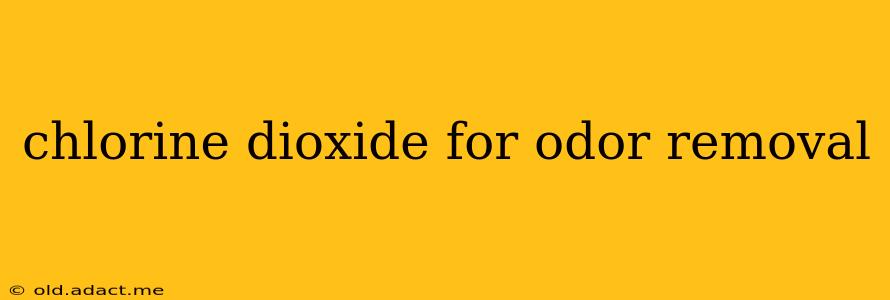Chlorine dioxide (ClO2) is a powerful oxidizing agent increasingly used for odor removal in various applications. Its effectiveness stems from its ability to break down odor-causing molecules, rather than simply masking them like many other odor eliminators. But is it the right solution for every situation? This comprehensive guide explores the uses, benefits, limitations, and safety considerations of chlorine dioxide for odor removal.
How Does Chlorine Dioxide Remove Odors?
Chlorine dioxide tackles odors by directly oxidizing the volatile organic compounds (VOCs) responsible for unpleasant smells. Unlike chlorine, which often reacts with organic matter to create new, potentially harmful compounds, ClO2 breaks down VOCs into less offensive and often harmless byproducts such as carbon dioxide and water. This oxidation process effectively neutralizes the odor at its source. This makes it particularly effective against persistent and stubborn odors that resist simpler masking techniques.
What Types of Odors Can Chlorine Dioxide Remove?
ClO2 has proven effective against a wide range of odors, including:
-
Biological Odors: These odors, often associated with bacteria, mold, and mildew, are effectively neutralized by ClO2's oxidizing properties. This makes it a popular choice for odor control in wastewater treatment and remediation of mold-affected areas.
-
Industrial Odors: Many industrial processes generate unpleasant odors. ClO2 can effectively eliminate odors from sources such as chemical plants, food processing facilities, and waste management operations.
-
Pet Odors: The strong odors associated with pet urine, feces, and other waste products can be effectively mitigated using chlorine dioxide. Its ability to break down the organic compounds responsible for the smell makes it a powerful tool for pet odor removal.
-
Smoke and Fire Odors: Following a fire, the lingering smell of smoke can be difficult to remove. ClO2's powerful oxidizing properties can effectively neutralize these odors, restoring a fresh scent to affected areas.
Is Chlorine Dioxide Safe for Odor Removal?
While highly effective, chlorine dioxide's use requires careful consideration of safety precautions. ClO2 is a powerful oxidizer and should be handled with appropriate safety equipment and training. Improper handling can lead to health risks, including respiratory irritation. Always follow the manufacturer's instructions and relevant safety guidelines when using chlorine dioxide for odor removal. Proper ventilation is crucial to minimize the risk of exposure.
What are the potential health risks associated with chlorine dioxide?
Exposure to high concentrations of chlorine dioxide can lead to respiratory irritation, coughing, and shortness of breath. Skin contact can cause irritation and burns. Therefore, appropriate personal protective equipment (PPE), such as gloves, goggles, and respirators, is essential when handling ClO2. Adequate ventilation is critical to ensure safe usage.
Are there any environmental concerns related to using chlorine dioxide for odor control?
While chlorine dioxide is effective at breaking down odor-causing compounds, its use should be carefully managed to minimize its environmental impact. Disposal of any residual chlorine dioxide solution should adhere to local environmental regulations. Minimizing the use of ClO2 and opting for appropriate dilution can help limit its environmental footprint.
What are the alternatives to chlorine dioxide for odor removal?
Several alternative methods exist for odor removal, each with its own advantages and disadvantages. These include ozone treatment, activated carbon filtration, air purifiers with HEPA filters, and the use of enzymatic cleaners. The best choice depends on the specific odor, the environment, and the desired level of effectiveness.
How effective is chlorine dioxide compared to other odor removal methods?
Compared to masking agents or simple air fresheners, chlorine dioxide offers a more permanent solution by actively breaking down odor-causing molecules. Its effectiveness rivals ozone treatment, but chlorine dioxide often provides better control and is potentially easier to manage in various settings.
Conclusion
Chlorine dioxide offers a powerful and effective solution for eliminating a wide range of persistent odors. However, its use requires careful consideration of safety precautions and environmental impacts. When used correctly and responsibly, chlorine dioxide can significantly improve air quality and eliminate unpleasant smells in diverse environments. Remember to always prioritize safety and follow the manufacturer's instructions and local regulations.
